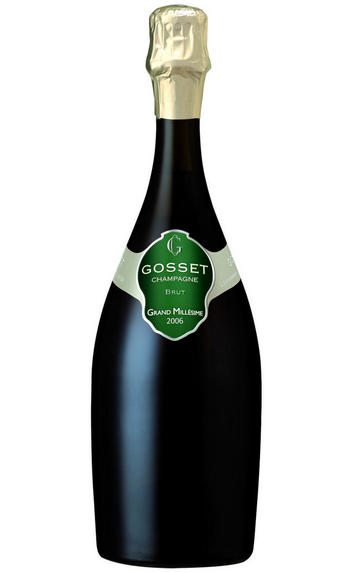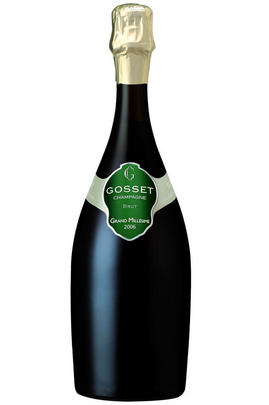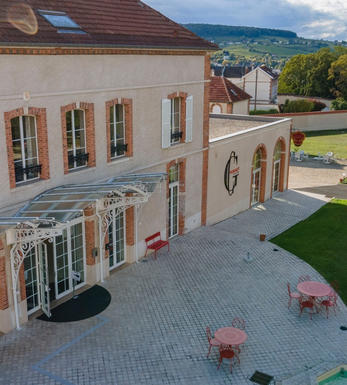
2006 Champagne Gosset, Grand Millésime, Brut

Critics reviews
Antonio Galloni - Nov-2015
William Kelley - 30/04/2019
Janicis Robinson - 29-Mar-2017
Wine Spectator - Mar-2016
About this WINE

Gosset
Gosset is the oldest wine-producer in Champagne, with a history stretching back to 1584 – when red, rather than sparkling wines were the region’s calling card.
Situated in the tiny Grand Cru village of Aÿ, five kilometres from Epernay, quality-focused Gosset has some rather famous neighbours, including Bollinger; its production, however, is much below that of the larger Houses, at around 1.3 million bottles (Moët & Chandon, for comparison, makes close to 30 million).
Gosset crafts truly artisan and gastronomic Champagnes, wines which are often seen in Michelin-star restaurants across the world. Newly appointed Chef de Caves Odilon de Varine (who took over in 2016) carries on the hallmark style of the House: extended aging “sur lees” in the cellars gives the wines extra richness and complexity in the finished glass, while the wines often don’tt undergo malolactic fermentation, to preserve the wines’ acidity and freshness. The results tend to be very creamy, dry and full, with rich, biscuit notes, framed by a trademark mineral freshness.
The House produces a range of different wines, including a range of non-vintage bottlings: the House’s flagship multi-vintage blend Grande Réserve, its Blanc de Blancs and Rosé. As for vintage wines, its Grand Millésime is joined by the “prestige” Celebris cuvées, which are only produced in the very best years.
Today the House is owned by the Renaud-Cointreau group, a family firm that also owns Cognac Frapin.

Brut Champagne
Brut denotes a dry style of Champagne (less than 15 grams per litre). Most Champagne is non-vintage, produced from a blend from different years. The non-vintage blend is always based predominately on wines made from the current harvest, enriched with aged wines (their proportion and age varies by brand) from earlier harvests, which impart an additional level of complexity to the end wine. Champagnes from a single vintage are labelled with the year reference and with the description Millésimé.
Non-vintage Champagnes can improve with short-term ageing (typically two to three years), while vintages can develop over much longer periods (five to 30 years). The most exquisite and often top-priced expression of a house’s style is referred to as Prestige Cuvée. Famous examples include Louis Roederer's Cristal, Moët & Chandon's Dom Pérignon, and Pol Roger's Cuvée Sir Winston Churchill.
Recommended Producers : Krug, Billecart Salmon, Pol Roger, Bollinger, Salon, Gosset, Pierre Péters, Ruinart

Champagne blend
Which grapes are included in the blend, and their proportion, is one of the key factors determining the style of most Champagnes. Three grapes are used - Pinot Noir, Chardonnay and Pinot Meunier.
26% of vineyards in Champagne are planted with Chardonnay and it performs best on the Côtes des Blancs and on the chalk slopes south of Epernay. It is relatively simple to grow, although it buds early and thus is susceptible to spring frosts. It produces lighter, fresher wines than those from Burgundy and gives finesse, fruit and elegance to the final blend. It is the sole grape in Blancs de Blancs, which are some of the richest long-lived Champagnes produced.
Pinot Noir accounts for nearly 40% of the plantings in Champagne and lies at the heart of most blends - it gives Champagne its body, structure, strength and grip. It is planted across Champagne and particularly so in the southern Aube district.
The final component is Pinot Meunier and this constitutes nearly 35% of the plantings. Its durability and resistance to spring frosts make the Marne Valley, a notorious frost pocket, its natural home. It ripens well in poor years and produces a soft, fruity style of wine that is ideal for blending with the more assertive flavours of Pinot Noir. Producers allege that Pinot Meunier lacks ageing potential, but this does not deter Krug from including around 15% of it in their final blends.


Buying options
Add to wishlist
Description
Lemon gold appearance with a delicate creamy mousse. The nose is rich and complex showing soft floral tones with citrus and orchard fruit entwined with hints of vanilla and hazelnut. The palate is fresh with an abundance of lemon and apple, a rich nuttiness with a hint of salinity balanced with inviting acidity and a rounded smooth finish. A delicious wine which will develop beautifully over time.
Champagne Gosset is the oldest wine producer in Champagne, dating back to 1584. Situated in the tiny Grand Cru village of Aÿ, 5km from Epernay, Gosset has some rather famous neighbours, including Bollinger. Gosset’s blends come from some of the best villages across the Marne Valley encompassing both Grand and Premier Crus. It may not be the most famous of the Grande Marques simply because they don’t produce vast quantities, making only 1.3 million bottles a year, yet the quality of production here is at a very high level.
With this small production, Gosset concentrates on the quality of its wines rather than the quantity. One of the distinguishing characteristics of the Gosset style comes from their decision to create most of their cuvées without the use of malolactic fermentation; this preserves the purity of the fruit in the wine. This is evident in the 2006 Gosset Grand Millésime. Having spent eight years maturing in the darkness of the Champagne Gosset cellars in Epernay, this 56 % Pinot Noir and 44 % Chardonnay wine is an excellent expression of the 2006 harvest (disgorged in spring 2015). With a “low dosage” and no malolactic fermentation this is a very precise Champagne, with a move away from the brioche, toast notes one often
wine at a glance
Delivery and quality guarantee